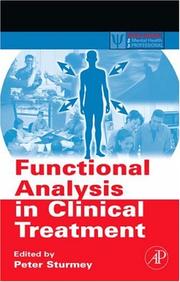| Listing 1 - 10 of 33 | << page >> |
Sort by
|
Book
ISBN: 9783319175690 3319175688 9783319175683 3319175696 Year: 2015 Publisher: Cham : Springer International Publishing : Imprint: Springer,
Abstract | Keywords | Export | Availability | Bookmark
 Loading...
Loading...Choose an application
- Reference Manager
- EndNote
- RefWorks (Direct export to RefWorks)
This book presents an evidence-based framework for replacing harmful, restrictive behavior management practices with safe and effective alternatives. The first half summarizes the concept and history of restraint and seclusion in mental health applications used with impaired elders, children with intellectual disabilities, and psychiatric patients. Subsequent chapters provide robust data and make the case for behavior management interventions that are less restrictive without compromising the safety of the patients, staff, or others. This volume presents the necessary steps toward the gradual elimination of restraint-based strategies and advocates for practices based in client rights and ethical values. Topics featured in this volume include: The epidemiology of restraints in mental health practice. Ethical and legal aspects of restraint and seclusion. Current uses of restraint and seclusion. Applied behavior analysis with general characteristics and interventions. The evidence for organizational interventions. Other approaches to non-restrictive behavior management. Reducing Restraint and Restrictive Behavior Management Practices is a must-have resource for researchers, clinicians and practitioners, and graduate students in the fields of developmental psychology, behavioral therapy, social work, psychiatry, and geriatrics.
Psychology. --- Developmental Psychology. --- Behavioral Therapy. --- Social Work. --- Philosophy (General). --- Social work. --- Developmental psychology. --- Travail social --- Psychologie du développement --- Restraint of patients. --- Social Sciences --- Psychology --- Development (Psychology) --- Patient restraint --- Patient restraints --- Physical restraint of patients --- Protective restraint of patients --- Restraint (Physiology) --- Restraints, Patient --- Behavioral therapy. --- Accidents --- Care of the sick --- Developmental psychobiology --- Life cycle, Human --- Prevention --- Benevolent institutions --- Philanthropy --- Relief stations (for the poor) --- Social service agencies --- Social welfare --- Social work --- Human services --- Behavioral therapy --- Behavior modification --- Psychotherapy

ISBN: 128096278X 9786610962785 0080471099 0123725445 0128134291 9780123725448 9780080471099 9780128134290 9780128054697 0128054697 Year: 2020 Publisher: Amsterdam : Academic Press,
Abstract | Keywords | Export | Availability | Bookmark
 Loading...
Loading...Choose an application
- Reference Manager
- EndNote
- RefWorks (Direct export to RefWorks)
"Much of clinical psychology relies upon cognitive behavior therapy to treat clinical disorders via attempting to change thinking and feeling in order to change behavior. Functional approaches differ in that they focus on context and the environmental influence on behavior, thoughts, and feelings. This second edition of Functional Analysis in Clinical Treatment updates the material in keeping with DSM-5 and ICD-10 and provides 40% new information, including updated literature reviews, greater detail in the functional analysis/assessment sections of each chapter, two new chapters on autism spectrum disorders and chronic health problems, and examples of worked assessments, such as interview transcripts, ABC charts, and observational data"--
Clinical psychology --- Functionalism (Psychology) --- Psychopathologie. --- Behandelingsmethoden. --- Methodology. --- Functional psychology --- Psychology --- Psychiatry --- Psychology, Applied --- Psychological tests --- Psychopathology. --- Methods of treatment. --- Psychology, Clinical --- Mental illness --- Psychology, Pathological --- therapy. --- Abnormal psychology --- Diseases, Mental --- Mental diseases --- Mental disorders --- Pathological psychology --- Psychology, Abnormal --- Psychopathology --- Neurology --- Brain --- Criminal psychology --- Mental health --- Psychoanalysis --- Madness --- Disabilities --- Diseases --- Clinical psychology. --- Mental Disorders --- Clinical Psychology --- Psychotherapy --- Clinical health psychology --- Health psychology --- Health psychology, Clinical --- Psychology, Clinical health --- Psychology, Health --- Salutogenesis --- Medicine and psychology
Book
ISBN: 3031315499 3031315480 Year: 2023 Publisher: Cham : Springer International Publishing : Imprint: Springer,
Abstract | Keywords | Export | Availability | Bookmark
 Loading...
Loading...Choose an application
- Reference Manager
- EndNote
- RefWorks (Direct export to RefWorks)
This book examines the nature, prevention, and treatment of violence within families. It reviews the definition of contemporary families, emphasizing various structures, including nuclear families, reconstituted families, gay and lesbian families, and recent immigrant families. In addition, the volume describes the nature of and risk factors for family violence from the perspectives of both victims (e.g., infants, children, seniors) and perpetrators (e.g., adolescent family members, women). It identifies the implications and explores strategies for prevention, treatment, and services. In addition, the volume directly addresses practice and evidence-based interventions for individual perpetrators, family interventions, interventions for victims and systemwide interventions (e.g., those involving the courts, police, and national policy). Chapters review the best available quality evidence from randomized controlled trials, systematic reviews, meta-analyses, research syntheses, and evidence-based recommendations from expert panels and government agencies. Case studies illustrate the application of evidence-based practice to violence within the family to demonstrate the effectiveness of the intervention. Topics featured in this book include: Definition and conceptualization of family. Definition and measurement of as well as risk factors for family violence. Family violence in various traditional and nontraditional families. Prevention strategies as well as Individual and family treatments for perpetrators and victims of family violence. Social policy and legal interventions for family violence. Violence in Families is a must-have resource for researchers, professsors, and graduate students as well as clinicians, therapists, and other professionals in developmental psychology, family studies, forensic psychology, criminology/criminal justice, public health, psychotherapy/counseling, psychiatry, social work, educational policy and politics, health psychology, nursing, and behavioral therapy/rehabilitation. .
Developmental psychology. --- Family policy. --- Forensic psychology. --- Juvenile delinquents. --- Public health. --- Social psychiatry. --- Developmental Psychology. --- Children, Youth and Family Policy. --- Forensic Psychology. --- Youth Offending and Juvenile Justice. --- Public Health. --- Clinical Social Work. --- Psychiatry, Social --- Clinical sociology --- Mental health --- Psychiatry --- Social medicine --- Social psychology --- Community health --- Health services --- Hygiene, Public --- Hygiene, Social --- Public health services --- Public hygiene --- Social hygiene --- Health --- Human services --- Biosecurity --- Health literacy --- Medicine, Preventive --- National health services --- Sanitation --- Delinquents --- Delinquents, Juvenile --- Juvenile offenders --- Offenders, Juvenile --- Offenders, Youthful --- Young offenders --- Youthful offenders --- Criminals --- Youth --- Juridical psychology --- Juristic psychology --- Legal psychology --- Psychology, Forensic --- Forensic sciences --- Psychology, Applied --- Families --- Families and state --- State and families --- Public welfare --- Social security --- Social policy --- Development (Psychology) --- Developmental psychobiology --- Psychology --- Life cycle, Human --- Government policy --- Violencia en la familia --- Política familiar --- Psicologia forense --- Delinqüència juvenil --- Psiquiatria social --- Violència familiar.

ISBN: 0471961701 Year: 1996 Publisher: Chichester : Wiley,
Abstract | Keywords | Export | Availability | Bookmark
 Loading...
Loading...Choose an application
- Reference Manager
- EndNote
- RefWorks (Direct export to RefWorks)
Clinical psychology --- Functionalism (Psychology). --- Mental disorders --- Psychology, Clinical --- Methodology. --- Diagnosis. --- Methods.
Book
ISBN: 047003291X 0470032928 9780470032916 9780470032923 Year: 2009 Publisher: Chichester, UK ; Malden, MA : John Wiley & Sons,
Abstract | Keywords | Export | Availability | Bookmark
 Loading...
Loading...Choose an application
- Reference Manager
- EndNote
- RefWorks (Direct export to RefWorks)
Clinical psychology --- Counseling --- Mental disorders --- Psychology, Clinical --- Psychotherapy --- Methodology. --- Diagnosis. --- Therapy. --- methods. --- Practice.
Book
ISBN: 9780471961703 Year: 1996 Publisher: Chichester Wiley
Abstract | Keywords | Export | Availability | Bookmark
 Loading...
Loading...Choose an application
- Reference Manager
- EndNote
- RefWorks (Direct export to RefWorks)
Digital
ISBN: 9783319175690 9783319175706 9783319175683 9783319359205 Year: 2015 Publisher: Cham Springer International Publishing
Abstract | Keywords | Export | Availability | Bookmark
 Loading...
Loading...Choose an application
- Reference Manager
- EndNote
- RefWorks (Direct export to RefWorks)
This book presents an evidence-based framework for replacing harmful, restrictive behavior management practices with safe and effective alternatives. The first half summarizes the concept and history of restraint and seclusion in mental health applications used with impaired elders, children with intellectual disabilities, and psychiatric patients. Subsequent chapters provide robust data and make the case for behavior management interventions that are less restrictive without compromising the safety of the patients, staff, or others. This volume presents the necessary steps toward the gradual elimination of restraint-based strategies and advocates for practices based in client rights and ethical values. Topics featured in this volume include: The epidemiology of restraints in mental health practice. Ethical and legal aspects of restraint and seclusion. Current uses of restraint and seclusion. Applied behavior analysis with general characteristics and interventions. The evidence for organizational interventions. Other approaches to non-restrictive behavior management. Reducing Restraint and Restrictive Behavior Management Practices is a must-have resource for researchers, clinicians and practitioners, and graduate students in the fields of developmental psychology, behavioral therapy, social work, psychiatry, and geriatrics.
Developmental psychology --- Cognitive psychology --- Psychology --- Social welfare methods --- sociaal werk --- ontwikkelingspsychologie --- gedragstherapie
Digital
ISBN: 9780128134290 0128134291 Year: 2020 Publisher: Amsterdam Academic Press
Abstract | Keywords | Export | Availability | Bookmark
 Loading...
Loading...Choose an application
- Reference Manager
- EndNote
- RefWorks (Direct export to RefWorks)
"This second edition of Functional Analysis in Clinical Treatment updates the material in keeping with DSM-5 and ICD-10 and provides 40% new information, including updated literature reviews, greater detail in the functional analysis/assessment sections of each chapter, two new chapters on autism spectrum disorders and chronic health problems, and examples of worked assessments, such as interview transcripts, ABC charts, and observational data."--Publisher's description

ISBN: 9780123725448 0123725445 9780080471099 0080471099 Year: 2007 Publisher: Boston Academic Press
Abstract | Keywords | Export | Availability | Bookmark
 Loading...
Loading...Choose an application
- Reference Manager
- EndNote
- RefWorks (Direct export to RefWorks)
WIth the ongoing pressures for psychologists to practice evidence-based care, and the requirement insurance carriers have both for treatment goals, measurement of outcomes, and a focus on brief therapy, functional analysis provides a framework for achieving all of the above. Having proven itself in treating behavioral problems in education, functional analysis is now being applied more broadly to behavioral and psychological disorders. In his 1996 book (Functional Analysis in Clinical Psychology, Wiley UK), Sturmey applied the functional behavioral approach to case formulation across a wide range of psychological disorders and behaviors. Since the publication of his book, no other volume has taken an explicit behavioral approach to case formulation. The changes that have occurred over the last 10 years in behavioral case formulation have been significant and substantial. They include (a) a large expansion of the range of problems addressed, such as ADHD, (b) a range of new verbal behavior therapies such as Acceptance and Commitment Therapies, (c) increased area of activity in the area of autism spectrum disorders; (d) many publications in how to train professionals, staff and parents in behavioral technology, and (e) new assessment instruments and procedures. *Makes theories of functional analysis accessible to a wide range of mental health professionals *Reviews behavioral assessment methods and strategies for case formulation *Offers readers a practical, organized, data-based means of understanding psychiatric conditions for intervening effectively and measuring positive change.
Book
ISBN: 9781119057550 Year: 2017 Publisher: Chichester John Wiley & Sons
Abstract | Keywords | Export | Availability | Bookmark
 Loading...
Loading...Choose an application
- Reference Manager
- EndNote
- RefWorks (Direct export to RefWorks)
| Listing 1 - 10 of 33 | << page >> |
Sort by
|

 Search
Search Feedback
Feedback About UniCat
About UniCat  Help
Help News
News